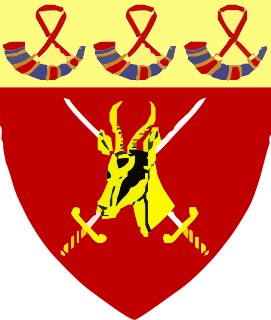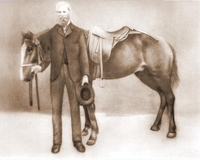
The history of people living in the area now known as Lesotho goes back as many as 400 years. The present Lesotho emerged as a single polity under King Moshoeshoe I in 1822. Under Moshoeshoe I, Basotho joined other clans in their struggle against the Lifaqane associated with famine and the reign of Shaka Zulu from 1818 to 1828.

The South African Army is the ground warfare branch of the South African National Defence Force. Its roots can be traced to its formation after the Union of South Africa was created in 1910. The South African military evolved within the tradition of frontier warfare fought by Boer Commando (militia) forces, reinforced by the Afrikaners' historical distrust of large standing armies. It then fought as part of the wider British effort in both World War I and World War II, but afterwards was cut off from its long-standing Commonwealth ties with the ascension to power of the National Party in South Africa in 1948. The army was involved in a long and bitter counter-insurgency campaign in Namibia from 1966 to 1990. It also played a key role in controlling sectarian political violence inside South Africa during the late 1980s and early 1990s.

The Basuto Gun War, also known as the Basutoland Rebellion, was a conflict between the Basuto and the British Cape Colony. It lasted from 13 September 1880 to 29 April 1881 and ended in a Basuto victory.

The Cape Corps and its predecessor units were the main military organisations in which the Coloured members of South Africa's population served.

Wepener is a town in the Free State, South Africa, located near the border of Lesotho.

The Thaba Bosiu Armour Regiment is a reserve armoured regiment of the South African Army.

The Mangaung Regiment is a reserve infantry regiment of the South African Army.

Lourens Jacobus (Louw) Wepener was born on 21 July 1812. He was the son of a German immigrant – Frederick Jacobus Wepener – and a Cape Colony woman – Johanna Maria Erasmus. Wepener was born in Graaf-Reinet and lived with his uncle – Lourens. He was christened by Reverend Andrew Murray of the Dutch Reformed Church. Wepener was first married to Hester Susanna Nel and then later to Hilletje Maria Levina Van Aardt. He had nine children with his second wife.

The Free State–Basotho Wars refers to a series of wars fought between King Moshoeshoe I, the ruler of the Basotho kingdom, and the white settlers, in what is now known as the Free State. These can be divided into the Senekal's War of 1858, the Seqiti War in 1865−1866 and the Third Basotho War in 1867−68.

The Louw Wepener Decoration, post-nominal letters LWD, is a military decoration for bravery which was instituted by the Union of South Africa in 1952. It was awarded to members of the South African Defence Force for acts of the most conspicuous courage or greatest heroism. The decoration was discontinued on 1 July 1975, when a new set of decorations and medals was instituted.

The Louw Wepener Medal, post-nominal letters LWM, is a South African military decoration for bravery which was instituted by the Republic of South Africa on 20 October 1967. It was awarded to members of the South African Defence Force for courageous or heroic deeds in saving lives. The Louw Wepener Medal was discontinued on 1 July 1975, when a new set of decorations and medals was instituted.

Thaba Bosiu is a sandstone plateau with an area of approximately 2 km2 (0.77 sq mi) and a height of 1,804 meters above sea level. It is located between the Orange and Caledon Rivers in the Maseru District of Lesotho, 24 km east of the country's capital Maseru. It was once the capital of Lesotho, having been King Moshoeshoe's stronghold.
The 4th South African Infantry Brigade was an infantry brigade of the army of the Union of South Africa during World War II. The Brigade formed part of the South African 2nd Infantry Division. The brigade served in the Western Desert Campaign until it was captured by German and Italian forces at Tobruk on 21 June 1942.

Orange Free State Command was a command of the South African Army, active from c. 1933 to c. 1999. Its headquarters was at Bloemfontein, seemingly for a period at the Tempe airfield, later to become the Tempe Military Base.

Wepener Commando was a light infantry regiment of the South African Army. It formed part of the South African Army Infantry Formation as well as the South African Territorial Reserve.

Regiment Dan Pienaar was an infantry battalion of the South African Army. As a reserve force unit, it had a status roughly equivalent to that of a British Army Reserve or United States Army National Guard unit.

Chief Albert Luthuli Regiment is a reserve infantry battalion of the South African Army.

The Battle of Berea was a battle between British forces under Sir George Cathcart and Basuto-Taung forces under King Moshoeshoe I and took place on 20 December 1852. The battle began when British forces broke into three columns and crossed the Caledon River, with the goal of seizing Basuto cattle as a form of punishment for past Basuto cattle raiding.

General Johan Isak Jacobus Fick was the founder of Ficksburg, a town in the Free State province, South Africa. After the Basotho Wars, peace was made and the town named after Johan Fick. He was also known as Commandant Generaal Johan Fick.

Masopha was a chief of the Basuto people. He was the third son of Basuto paramount chief Moshoeshoe I. During his youth he fought in numerous conflicts against neighboring tribes and European colonists, distinguishing himself for his bravery. Following the incorporation of Basutoland into the Cape Colony, Masopha resisted the imposition of colonial rule and emerged as one of the most powerful Basuto chiefs. In 1880, he became one of the leaders of Basuto resistance to the Cape in the Basuto Gun War. Following the end of the war he came into conflict with his nephew and heir apparent Lerotholi. The two clashed in a brief civil war in January 1898. Masopha was defeated and died in obscurity in July 1898.





















